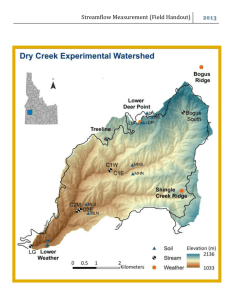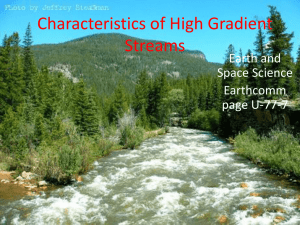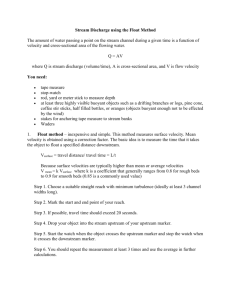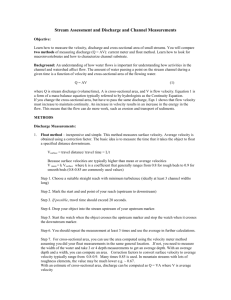Assignment
advertisement
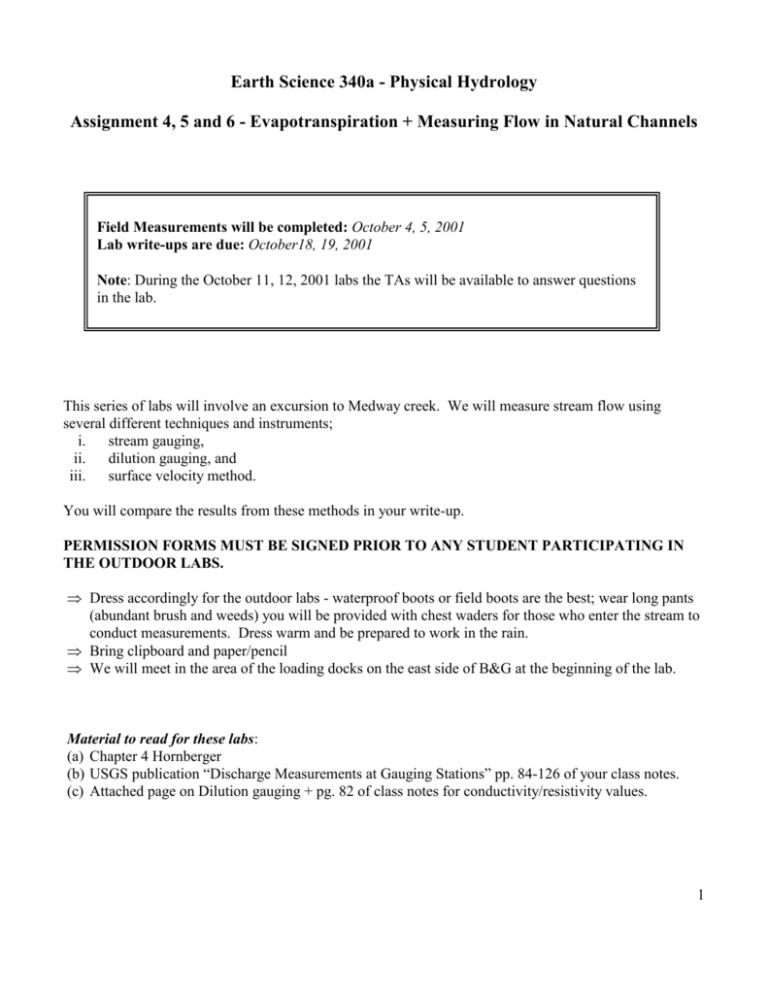
Earth Science 340a - Physical Hydrology Assignment 4, 5 and 6 - Evapotranspiration + Measuring Flow in Natural Channels Field Measurements will be completed: October 4, 5, 2001 Lab write-ups are due: October18, 19, 2001 Note: During the October 11, 12, 2001 labs the TAs will be available to answer questions in the lab. This series of labs will involve an excursion to Medway creek. We will measure stream flow using several different techniques and instruments; i. stream gauging, ii. dilution gauging, and iii. surface velocity method. You will compare the results from these methods in your write-up. PERMISSION FORMS MUST BE SIGNED PRIOR TO ANY STUDENT PARTICIPATING IN THE OUTDOOR LABS. Dress accordingly for the outdoor labs - waterproof boots or field boots are the best; wear long pants (abundant brush and weeds) you will be provided with chest waders for those who enter the stream to conduct measurements. Dress warm and be prepared to work in the rain. Bring clipboard and paper/pencil We will meet in the area of the loading docks on the east side of B&G at the beginning of the lab. Material to read for these labs: (a) Chapter 4 Hornberger (b) USGS publication “Discharge Measurements at Gauging Stations” pp. 84-126 of your class notes. (c) Attached page on Dilution gauging + pg. 82 of class notes for conductivity/resistivity values. 1 Part A. Evapotranspiration 1. Measurements of water-balance components have been made for a one-year period on a lake with an area of 4.2 km2 and a drainage basin of 52.1 km2 (including the lake), with the following results: precipitation=108.3 cm surface water flow into the lake=2.33x107 m3 ground water discharge into the lake=2.2x105 m3 ground water discharge out of the lake=0.6x105 m3 surface water flow out of the lake=2.70x107 m3 The lake-surface elevation, h, at the end of the year was 10.8 cm higher than at the beginning of the year. What is the water-balance estimate of the lake evaporation for that year? 2. Given the following average meteorological conditions for Lake St. Clair on September 10, 2001 calculate the open water evaporation rate (potential evapotranspiration rate) using the energy-balance approach. air temperature=22.3C air vapor pressure=18.36 mb psychrometric constant ()=0.66 mb C-1 surface temperature=23.7C surface vapor pressure=29.4 mb net solar radiation input= 300 W m-2 Ts Ta Note: is the proportionality constant in equation 2.13 of your text so B es ea Available data indicate the change in heat storage for the lake was negligible over this date. Assume that conduction to the ground is 0 W m-2 and v=2.45x106 J kg-1 (at 20C; the latent heat of vaporization decreases as the temperature of the evaporating surface increases). 2 Part B. – Measuring Flow in Natural Channels: Velocity-Area Method 1. (a) The velocity-area method is discussed in detail in your textbook and the USGS document on stream gauging (class notes). Given the channel cross-section in Figure 6.4 and data from field observations in Table 6.1 calculate stream discharge. You should do this problem by hand and also using a spreadsheet. Set up (program) your spreadsheet so it calculates the discharge upon input of field data. Set-up your table/spreadsheet with column headings: vertical#, distance, depth, average velocity, flow. Label headings with appropriate units. (b) Explain how you could increase the accuracy of this stream gauging exercise. Table 6.1 Vertical distance (m) depth (m) 0 1 2 3 4 5 6 7 0 1.28 2.29 3.75 5.34 6.47 8.02 9.83 0 1.22 1.52 2.20 2.27 2.16 1.43 0 average velocity (m/s): twotenths-and-eight-tenthsdepth method 0 0.64 0.70 0.82 0.85 0.76 0.67 0 Notes: Use the mid-section method (Figure 1 pg. 95 class notes). Figure 6.4 3 Part C - Measuring Flow in Natural Channels: Field Exercises on Medway Creek Velocity-Area Method 1. Using the Velocity-Area Method calculate the discharge at the section of Medway Creek. Did the section adhere to the conditions outlined in the USGS publication? Using your spreadsheet from problem 1 (modify method if needed i.e. 6th tenths vs. two-tenths-and-eight-tenths-depth method) enter your field data and complete the calculations for total stream discharge. 2. Using your velocity measurements obtained in part 1, and a measurement of average slope of the riverbed (data to be provided on the summary data sheet), calculate the Manning number for the creek. Assume the creek width is much greater than the depth (i.e. hydraulic radius=average channel depth). Dilution Gauging 3. Use dilution gauging to calculate the discharge on the selected reach of Medway Creek. Clearly note what section of the creek you obtained the data from (point of injection and distance to conductivity measurement) and when you obtained the data. Use the data in the conductivity table to develop a calibration curve between conductivity and concentration in the stream water. Next plot the concentration at the downstream side Cd(t)-versus-time(t) curve. From this calculate the stream discharge. Finally, calculate the mixing length Lmix (equation F-12 attached handout) and compare this to the actual mixing length used in the field. 4. Calculate the Manning coefficient for the same reach of Medway Creek that you used for dilution gauging. Use your discharge / average velocity values obtained from the dilution gauging. For this calculation you will also require the average hydraulic radius and the average channel slope. Calculate the hydraulic radius (ratio of channel cross-sectional area to wetted perimeter) using measuring tape and staff/ruler at several locations. Calculate the average slope using the elevation data provided in the summary data sheet. 5. Calculate the Reynolds number for the stream. Is the flow turbulent or laminar? Surface Velocity Method 6. Calculate the discharge via the surface velocity method. Indicate how you obtained your average cross sectional area. 7. Compare the estimates of discharge that you obtained with all three methods. Are they significantly different? If so explain why? 4

